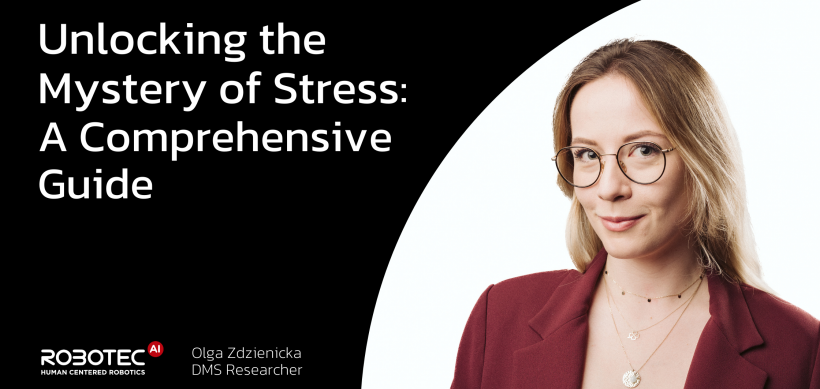Enter the search phrase

Author:
Olga Zdzienicka, DMS Researcher @ Robotec.ai
Disclaimer: The text you are about to read is just a small scratch on the surface. The topics of the article are much better described in Robotec.ai’s Handbook on Driver Stress Detection. The book is available here, be sure to check it out!
Understanding stress is crucial in navigating the complexities of modern life, as it affects our health, behavior, and overall well-being. We come into contact with stress every day – at home, at work, while driving… That’s right! Stress in drivers can have a huge impact on driving safety and overall road safety (Bustos et al., 2021; Reimer et al., 2016). But how do we study this phenomenon? Using subjective measures, among others, of course.
Questionnaires and surveys serve as the cornerstone of subjective assessment, offering valuable insights into individuals’ minds, for example, one’s perceptions of stress. These tools have evolved over decades, catering to various aspects of stress research, from perceived stress levels, and stressors exposure to susceptibility and coping mechanisms (Crosswell & Lockwood, 2020).
In the realm of self-report studies, the diversity of methodologies is striking. Questionnaires can take myriad forms – written or oral, paper-based or digital, retrospective or real-time. This adaptability allows researchers to tailor their approach to different demographics and contexts, whether they examine adolescents, undergraduates, or professionals. (Cahir & Morris, 1991; Crandall et al., 1992; Pekruna, 2020).

Source: Image by Alex Green from Pexels
So, as you might guess, such tools may also be successfully implemented in studies or the detection of stress in drivers. Correct stress identification in drivers is a necessary step in the development of systems preventing its occurrence or assisting drivers in stressful situations, thus increasing road safety.
In the realm of driver stress research, the utilization of various questionnaires and scales is pervasive. From numerical rating scales to visual analog scales, researchers endeavor to quantify the subjective experience of stress, allowing drivers to articulate their stress levels and identify contributing factors. Moreover, researchers often seek to understand the nuances of stress in driving contexts through open-ended questions and checklists. By soliciting drivers’ narratives, researchers gain deeper insights into specific stressors and their impact on driving behavior (Balters et al., 2021; Healey & Picard, 2000).
The landscape of driver stress research is embellished with an array of tailored questionnaires designed to probe into the intricacies of stress within this domain. Whether it’s assessing personality traits, coping strategies, or specific driving situations, researchers employ a diverse toolkit to dissect the complexities of driver stress.
For instance, Hennessy and Wiesenthal (1999) employed a suite of questionnaires to investigate the interplay between traffic congestion and driver stress. By combining multiple instruments, researchers aim to unravel the multifaceted nature of stress in driving contexts.
In addition to traditional stress assessments, researchers delve into the cognitive dimensions of driver stress through cognitive load questionnaires. These tools provide insights into drivers’ mental workload, decision-making processes, and performance under varying driving conditions (Huang et al., 2016; Reimer, 2009).
By evaluating drivers’ cognitive load, researchers gain a deeper understanding of how stressors impact cognitive processing and attention allocation while driving. Moreover, cognitive load questionnaires enable the evaluation of interventions aimed at reducing stress and enhancing driving performance.

Source: Image by johnhain from Pixabay
Despite their utility, self-report surveys pose certain challenges. Cultural and language barriers can impede participants’ comprehension and response accuracy, necessitating cultural and linguistic adaptations. Moreover, the inherent biases in self-reporting, such as social desirability bias, warrant careful scrutiny of responses.
Researchers must also contend with participants’ ability to provide accurate and relevant answers. A proper explanation of the study’s significance and diligent outlier detection mechanisms mitigate these concerns to some extent. Nonetheless, the limitations of self-report-based research underscore the need for a judicious balance between insights and biases.
However, although self-report measures may seem on the surface to be suboptimal and unreliable, they are an important complement to objective measures. They are also convenient, non-invasive, and offer great convenience when surveying large groups with diverse backgrounds. Surveys of this type are an essential element in research involving humans, including research on stress.
Self-report surveys stand as indispensable tools in stress research, offering unparalleled access to individuals’ subjective experiences. While they come with inherent limitations, their versatility and adaptability make them crucial in constructing comprehensive studies.
By combining subjective assessments with objective measures, researchers can paint a holistic picture of stress, enriching our understanding of this pervasive phenomenon. In navigating the intricacies of stress research, self-report surveys remain a beacon, guiding us toward greater insights and discoveries.
If you have interesting insights on the topic of subjective measures, stress detection, or… subjective measures in stress detection, or would like to discuss potential projects with us, contact us via humanfactors@robotec.ai!
🔴 Ready for more knowledge? Download the handbook here and dive into the fascinating research of driver stress detection curated by Anna and Olga.
🔴 Curious about our latest projects? Follow us on LinkedIn to always stay updated!
References:
Balters, S., Gowda, N., Ordonez, F., & Paredes, P. E. (2021). Individualized stress detection using an unmodified car steering wheel. Scientific reports, 11(1), 20646.
Bustos, C., Elhaouij, N., Sole-Ribalta, A., Borge-Holthoefer, J., Lapedriza, A., & Picard, R. (2021, September). Predicting driver self-reported stress by analyzing the road scene. 2021 9th International Conference on Affective Computing and Intelligent Interaction (ACII) (pp. 1–8). IEEE.
Cahir, N., & Morris, R. D. (1991). The psychology student stress questionnaire. Journal of clinical psychology, 47(3), 414–417
Crandall, C. S., Preisler, J. J., & Aussprung, J. (1992). Measuring life event stress in the lives of college students: The Undergraduate Stress Questionnaire (USQ). Journal of behavioral medicine, 15, 627–662.
Crosswell, A. D., & Lockwood, K. G. (2020). Best practices for stress measurement: How to measure psychological stress in health research. Health psychology open, 7(2), 2055102920933072.
Healey, J., & Picard, R. (2000, September). SmartCar: detecting driver stress. In Proceedings 15th International Conference on Pattern Recognition. ICPR-2000 (Vol. 4, pp. 218–221). IEEE.
Hennessy, D. A., & Wiesenthal, D. L. (1999). Traffic congestion, driver stress, and driver aggression. Aggressive Behavior: Official Journal of the International Society for Research on Aggression, 25(6), 409–423.
Huang, M. X., Li, J., Ngai, G., & Leong, H. V. (2016, October). Stressclick: Sensing stress from gaze-click patterns. In Proceedings of the 24th ACM international conference on Multimedia (pp. 1395–1404).
Pekruna, R. (2020). Commentary: Self-Report Is Indispensable to Assess Students’ Learning. Frontline Learning Research, 8(3), 185–193.
Reimer, B. (2009). Impact of cognitive task complexity on drivers’ visual tunneling. Transportation Research Record, 2138(1), 13–19.
Reimer, B., Mehler, B., & Coughlin, J. F. (2016). Reductions in self-reported stress and anticipatory heart rate with the use of a semi-automated parallel parking system. Applied ergonomics, 52, 120–127.